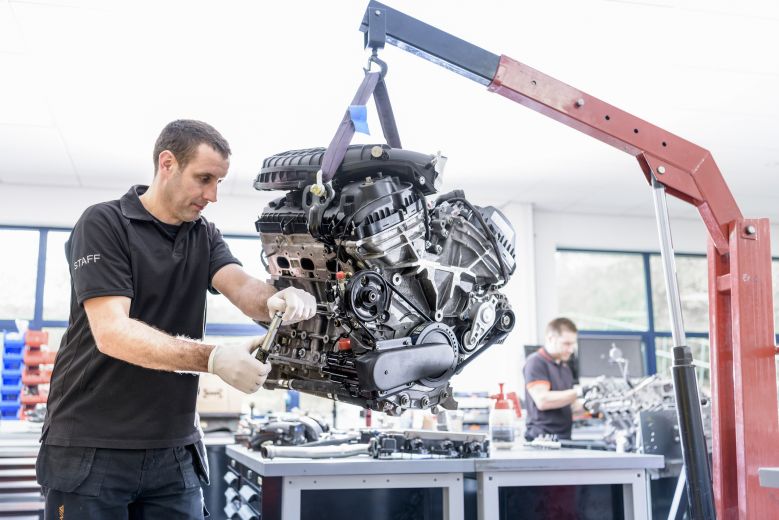Although there are several types – Internal Combustion Engines (ICE), hybrids and electric vehicles – there is another one used, called a rotary engine.
However, these are less commonly seen on UK roads. Here, we explain all you need to know, and how much it costs to replace them.
Read our latest know how guide below.
Car rotary engine
Also known as a Wankel engine, a rotary engine uses a rotary design rather than pistons and cylinders to power the engine, and move the vehicle.
It is a type of internal combustion engine that instead of pistons moving up and down within cylinders, rotary engines use a triangular or oval rotor that spins in an eccentric motion within a housing unit.
These engines have a unique design that differs from traditional piston engines, offering advantages such as high power-to-weight ratio and smooth operation. However, they are less common than piston engines in modern cars due to challenges with fuel efficiency and emissions.
How does a rotary engine work?
A rotary engine uses the oval or triangular rotor itself to power the engine.
It rotates within the housing, and uses its three sides, or lobes, which create chambers of varying size as it spins.
The housing provides support and structure for the rotor within the engine.
As the rotor spins within the housing, it creates three sealed chambers of varying size. These chambers expand and contract as the rotor rotates, allowing for the intake, compression, combustion, and exhaust phases of the engine cycle to occur.
Much like other internal combustion vehicles, a rotary engine utilises spark plugs, fuel injectors, and other engine components to maintain the speed and output when the car is in use – and protects other parts of the vehicle from any potential damage.
Advantages of rotary engines
Rotary engines offer several advantages over other engines available in cars today.
These include high power-to-weight ratio, compact size, and smooth operation. This is why they are likely found in smaller sports vehicles, rather than larger SUVs and saloon cars.
Challenges of a rotary engine
The main reason why rotary engines aren’t a popular choice in today’s car market, is due to their lower fuel efficiency and higher emissions.
Which stage in the rotary engine cycle do the spark plugs fire the air and fuel?
In a rotary engine, the spark plugs fire during the combustion stage of the engine cycle, where the air and fuel are mixed together.
When the rotary engine seals off one of the chambers created by its movement, the air-fuel mixture is compressed, then ignited by the spark plugs.
This is a very similar process to the majority of internal combustion vehicles, and is not exclusive to rotary-powered vehicles.
Who invented the rotary engine?
German manufacturer Felix Heinrich Wankel invented the rotary engine in 1920, at the age of just 17 years old.
This is why it is also known as the Wankel engine.
However, the rotary engine’s first patent was signed in 1934.
What cars have a rotary engine?
Although rotary engines in cars were popularised by Japanese manufacturer, Mazda, they have been used in various vehicles over the decades.
They are rarely seen on UK roads today, but Volkswagen, Citroen, and Mercedes-Benz have all used rotary engines in their range of vehicles.
Rolls-Royce commonly used rotary engines in their military vehicles.
How much does a rotary engine cost?
If you are looking to buy a new or replacement rotary engine for your car, you will likely be spending more than £4,000.
However, they can be significantly more, due to their rarity, quality and who the manufacturer is.
Diesel rotary engine
Rotary engines are most commonly found in petrol-powered internal combustion vehicles – but there have been a few diesel versions.
However, these have been limited to prototypes and ‘kit cars’ where people can build their own vehicle.
The Wankel Diesel Engine was a principle that was developed in the 1970s, but no vehicle made it into full production.
Keep your engine running smoothly
The RAC recommends regular oil changes help keep your engine running smoothly and extend its life. Book an RAC Mobile Mechanic today.


Rotary engine size
Due to the relatively small number of rotary engines that have been mass produced, there are seven sizes available: 0.4L, 0.8L, 1.0L, 1.2L, 1.3L, 2.0L, and 2.6L.
There were other sizes tested during prototype testing, but never made it into mass production for a vehicle manufacturer.
Some of these had a turbocharger added to them, which changed the power output of the vehicle.

Cheaper than AA or we’ll beat by 20%^
• Roadside cover from £5.49 a month*
• We get to most breakdowns in 60 mins or less
• Our patrols fix 4/5 breakdowns on the spot











